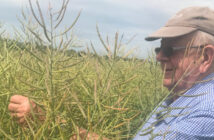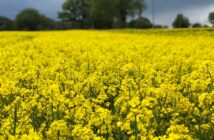Oilseed rape growers should be looking to target virus carrying aphids early to prevent yield robbing levels of virus infecting crops. Results of Plenum trials on a Syngenta Innovation Centre last season highlighted that hitting aphid populations as they built up protected in the highest yields.
Plenum application timed when the numbers of Myzus persicae caught in water trap monitoring in Hampshire started to increase, doubling from 10 aphids per trap to over 20 in the course of a week, resulted in over 6% higher yield, compared to treatment a week later, when aphid numbers peaked. Treatment delayed by a further week, when aphid numbers had begun to naturally decline, also resulted in lower yields. Untreated OSR yields were over 10% lower.
Syngenta Field Technical Manager, Pete Saunders, attributed the field losses from later aphid control to infection of TuYV (Turnip Yellows Virus). “Although last year was a relatively low risk season for aphid pressure and virus losses, the trial still demonstrated the importance of preventing infection in the first instance.
“In a higher risk season, the yield benefits and the reduction in virus spread would likely be far more pronounced,” he said. The Myzus persicae aphid is the key vector of TuYV, with up to 70% of aphids found to be carrying the virus when they move into oilseed rape crops.
“The virus is endemic in a wide range of weed species in field hedgerows and surrounding fields. Aphid migrating from other crops, as potatoes are burnt down and brassicas harvested, for example, readily acquire infection and will quickly pass it onto oilseed rape plants as they move across a field,” he warned.
Early autumn TuYV infection causes the greatest yield losses, and creates a reservoir of disease that could be further spread as other aphids feed.
The threat has been further compounded by the level of resistance to pyrethroid insecticides among Myzus persicae populations. “At this time of year many growers do not have the time for a ‘wait and see’ approach from an initial pyrethroid application or the additional cost of a second spray pass, and the trial confirms the potential yield losses from delayed control of Myzus.
“If growers or agronomists suspect pyrethroid resistance has been an issue in the past, or in-crop monitoring shows aphid numbers are building rapidly, early intervention with Plenum has been shown to be the best way to control aphids – to prevent virus spread and protect yields,” he advised.



